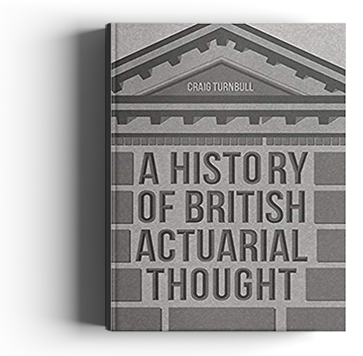
05 Nov 2016 A History of British Actuarial Thought
Dear Friends and Colleagues,
I would humbly like to bring to your attention the forthcoming publication of my book, A History of British Actuarial Thought. The book is scheduled for release on 25th November and is published by Palgrave Macmillan.
You can order your copy here: http://www.palgrave.com/gb/book/9783319331829
What is the book about?
A History of British Actuarial Thought traces the development and implementation of actuarial ideas in British life assurance, pensions and general insurance from the conception of Equitable Life in the mid-18th century to the start of the 21st century.
The book discusses how new actuarial approaches were developed within each of the three key practice areas of life assurance, pensions and general insurance. It analyses how these emerging ideas interacted with each other and were often driven by common external factors such as shocks in the economic environment, new intellectual ideas from academia and developments in technology.
A broad range of historically important actuarial topics are discussed such as the development of the blueprint for the actuarial management of with-profit business; historical developments in mortality modelling methods; the emergence of actuarial thinking on investment strategy for life and pensions business; changing perspectives on the objectives and methods for funding Defined Benefit pensions; the history of early actuarial thinking in general insurance fields such as fire insurance; the application of risk theory in general insurance reserving; and the Guaranteed Annuity Option crisis at the end of the 20th century.
The book also provides an historical overview of some of the most important external contributions to actuarial thinking: in particular, the early modern thinking on probability and statistics, starting in the 1650s with Pascal and Fermat; and the developments in the field of financial economics over the third quarter of the twentieth century. The book identifies where historical actuarial thought heuristically anticipated some of the fundamental ideas of modern finance, and the challenges that the profession wrestled with in reconciling these ideas with traditional actuarial methods.
Who is the book written for?
The book provides a comprehensive intellectual background that delivers an enlightening and rewarding perspective for both the seasoned actuarial practitioner and the professional and academic actuarial student. It will also provide the non-actuarial financial practitioner (investment managers, quantitative analysts, risk managers, accountants, bankers) with a window into the sometimes opaque, perplexing and jargon-filled world of the actuary.
What do others think?
The book has been endorsed by a number of leading actuarial thinkers, including Colin Wilson, the President of the Institute and Faculty of Actuaries, who commented:
“The author sets himself a hugely challenging task to provide a coherent outline of the development of actuarial thought in Britain in a few hundred pages. He succeeds triumphantly, without shying away from some notable controversies. This very readable account sets the key developments in the context of broader financial thinking and highlights those areas where with the benefit of hindsight faster progress might have been made. Anyone seeking a better understanding of the rationale behind current actuarial methods or an insight into how these might develop in the future would be well advised to read this book.”
Any questions or feedback you have relating to the book are most welcome. Thank you for reading.
You can pre-order your copy here: http://www.palgrave.com/gb/book/9783319331829

No Comments